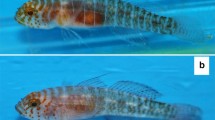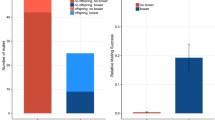Abstract
This study examins the flexibility of the reproductive styles in St. Peter's tilapia, Sarotherodon galilaeus (Cichlidae). Three years of monitoring and filming 111 reproduction cycles involving 15 individually marked males, revealed their behavioural repertoire to contain 12 dominant groups of tactics (marked A to L), revolving around three parameters: territoriality (T) or non-territoriality (NT) during spawning; brooding-participating (Br) or non participating (NBr) in brooding eggs; and pairing (P) or not forming (NP) pair bond with the selected female. The males demonstrate an ability to select alternative reproductive styles (ARS) that presented various combinations of the three major parameters. The most dominant group comprised T (territorial) males, which tended not to brood eggs and to desert the female after mating. However, over various reproductive cycles the same males also altered their behaviour from one tactic to another. Territoriality was the most conservative tactic, while brooding or not brooding was the most frequently changed tactic. Some types of males remained with their selected mate for one spawning only, whereas others stayed for up to five cycles, showing a high tendency toward monogamy. In some instances the presence of additional females influenced the decision-making of the male, decreasing his fidelity to his mate. The rich variety of reproductive tactics in S. galilaeus males and their ability to change from one tactic to another, characterizes the high flexibility and adaptability of this species. These qualities could be used to describe ecobehavioural morphs, similar to descriptions of ecomorphological or ecophysiological phenotypes.
Similar content being viewed by others
References cited
Arkes, H.R. & K.R. Hammond (ed.) 1986. Judgment and decision making: an interdisciplinary reader. Cambridge University Press, London. 270 pp.
Baerends, G.P. & J.M. Baerends van Roon. 1950. An introduction to the study of the ethology of cichlid fishes. Behaviour, Suppl. 1: 1–243.
Balon, E.K. 1989. The epigenetic mechanism of bifurcation and alternative life-history styles. pp. 467-501. In: M.N. Bruton (ed.) Alternative Life-History Styles of Animals, Kluwer Academic Publishers, Dordrecht.
Balon, E.K. 1990. Epigenesis of an epigeneticist: the development of some alternative concepts on the early ontogeny and evolution of fishes. Guelph Ichthyol. Rev. 1: 1–42.
Balshine-Earn, S. 1997. The benefits of uniparental versus biparental mouth brooding in Galilee St. Peter's fish. J. Fish Biol. 50: 371–381.
Balshine-Earn, S. & D.J.D. Earn. 1997. An evolutionary model of parental care in St. Peter's fish. J. Theor. Biol. 184: 423–431.
Barlow, G. 1977. Modal action paterns. pp. 99–134. In: Th.A Sebeok (ed.) How Animals Communicate, University Press, Bloomington-London.
Bonner, J.T. 1980. The evolution of culture in animals. Princeton University Press, Princeton. 280 pp.
Cant, M.A. 1998. A model for evolution of reproductive skew without reproductive suppression. Anim. Behav. 55: 163–169.
Carroll, S.P. 1993. Divergence in male mating tactics between two populations of the soapberry bug: I. Guarding versus nonguarding. Behav. Ecol. 4: 156–164.
Eggert, A.K. 1992. Alternative male mate-finding tactics in burying beetles. Behav. Ecol. 3: 243–254.
Emlen, S.T. & L.W. Oring. 1977. Ecology, sexual selection and the evolution of mating systems. Science 197: 215–223.
Eyeson, K.N. 1992. Residual biparental oral brooding in the blackchin fish, Sarotherodon melanotheron Ruppell. J. Fish Biol. 41: 145–146.
Fishelson, L. 1966. Untersuchungen zur vergleichenden Entvicklungsgeschichte der Gattung Tilapia (Cichlidae, Teleostei). Zool. Jahrb. (Anat.) 83: 571–656.
Fishelson, L. 1967. Cichlidae of the genus Tilapia in Israel. Bamidgeh 18: 67–80.
Fishelson, L. 1970. Behaviour and ecology of a population of Abudefduf saxatilis (Pomacentridae, Teleostei) at Eilat (Red Sea). Anim. Behav. 18: 225–237.
Fishelson, L. 1983. Social behaviour of adult tilapia fish in captivity (Israel). pp. 48–58. In: L. Fishelson & Z. Yaron (ed.) Proceedings of the International Symposium on Tilapia in Aquaculture, Tel-Aviv University Press, Tel Aviv.
Fishelson, L. & W. Heinrich. 1963. Some observations on the mouthbrooding Tilapia galilaea L. (Pisces: Cichlidae). Ann. Magaz. Nat. Hist. 13: 507–509.
Fryer, G. & T.D. Iles. 1972. The cichlid fishes of the Great Lakes of Africa. Oliver and Boyd, Edinburg. 450 pp.
Golani, I. & G. Moran. 1983. A motility-immobility gradient in the behaviour of the “inferior” wolf during “ritualized fighting”. pp. 65–94. In: J. Eisenberg & D. Kleinman (ed.) Advances in the Study of Animal Behaviour, American Society of Mammalogists, Special Publication 7.
Gross, M.R. 1986. Sunfish, salmon, and the evolution of alternative reproductive strategies and tactics in fish. pp. 55-75. In: G.W. Potts & R.J. Wootton (ed.) Fish Reproduction: Strategies and Tactics, Academic Press, London.
Gross, M.R. & E.L. Charnov. 1980. Alternative male life histories in bluegill sunfish. Proc. Nat. Acad. Sci. 77: 6937–6940.
Heinrich, W. 1967. Untersuchungen zum sexualverhalten in der Gattung Tilapia (Cichlidae, Teleostei) und ihre Artbastarden. Z. Tierpsychol. 24: 684–754.
Huntingford, F. 1984. The study of animal behaviour. Chapman & Hall, London. 411 pp.
Iles, T.D. & M.J. Holden. 1969. Bi-parental mouth brooding in Tilapia galilaea (Pisces, Cichlidae). J. Zool. (London) 158: 327–333.
Janetos, A.C. 1980. Strategies of female mate choice: a theoretical analysis. Behav. Ecol. Sociobiol. 7: 107–112.
Johnstone, R.A. 2000. Models of reproductive skew: a reviewand synthesis. Ethology 106: 5–25.
Keenleyside, M.H.A. (ed.) 1991. Cichlid fishes: behaviour, ecology and evolution. Chapman & Hall, London. 380 pp.
Keenleyside, M.H.A., R.C. Bailey & V. Young. 1990. Variation in the mating system and associated parental behaviour of captive and free-living Cichlasoma nigrofasciatum (Pisces, Cichlidae). Behaviour 112: 202–221.
Konings, A. 1991. Musings on the evolution of cichlids. Tropical Fish Hobbyists Novitatus 88–104.
Kuwamura, T. 1986. Parental care and mating systems of cichlid fishes in the Lake Tanganyika: a preliminary field survey. J. Ethol. 4: 129–146.
Larsen, T. 1991. Antipredator behaviour and mating systems in waders: aggressive nest defence selects for monogamy. Anim. Behav. 41: 1057–1062.
Lemel, J. & K. Wallin. 1993. Status signaling, motivational condition and dominance: an experimental study in the great tit, Parus major L. Anim. Behav. 45: 549–558.
Loiselle, P.V. 1985. The cichlid aquarium. Tetra-Press, Melle. 430 pp.
Maynard-Smith, J. 1977. Parental investment: a prospective analysis. Anim. Behav. 25: 1–9.
Oliveira, R.F. & V.C. Almada. 1996. On the (in)stability of dominance hierarchies in the cichlid fish, Oreochromis mossambicus. Aggres. Behav. 22: 37–45.
Oliveira, R.F., A.V.M. Canario & R. Bshary. 1999. Hormones, behaviour and conservation of littoral fishes: current status and prospects for future research. pp. 149-178. In: V.C. Almada, R.F. Oliveira & E.J. Goncalves (ed.) Behaviour and Conservation of Littoral Fishes, ISPA, Lisbon.
Oppenheimer, J.R. 1970. Mouthbrooding in fishes. Anim. Behav. 18: 493–503.
Peters, H.M. 1961. Einige verhaltensweisen bei Buntbarschen und ihre Grundlagen. Die Natur 69: 145–154.
Peters, H. & S. Berns. 1979. Regression and progression in der Evolution maulbrutender Cichliden. Mitteil. Hamburger Zoolog. Mus. & Inst. 76: 506–508.
Peters, H. & S. Berns. 1982. Die Maulbrutpflege der Cichliden. Untersuchungen zur Evolution eines Verhaltensmusters. Zeitschr. Zool. Syst. & Evolutionfor. 20: 18–52.
Roithmair, M.E. 1992. Territoriality and male mating success in the dart-poison frog, Epipedobates femoralis (Dendrobatidae, Anura). Ethology 92: 331–343.
Schwanck, E. & K. Rona. 1991. Male-female parental roles in Sarotherodon galilaeus (Pisces:Cichlidae). Ethology 89: 229–243.
Sargent, R.C. & M.R. Gross. 1985. Parental investment, decision rules and the Concord fallacy. Behav. Ecol. Sociobiol. 17: 43–45.
Taborsky, M. 1994. Sneakers, satellites and helpers: parasitic and cooperative behaviour in fish reproduction. Advan. Stud. Behav. 23: 1–100.
Taborsky, M. 1999. Conflict or cooperation: what determines optimal solutions to competition in fish reproduction? pp. 301–349. In: V.C. Almada, R.F. Oliveira & E.J. Goncalves (ed.) Behaviour and Conservation of Littoral Fishes, ISPA, Lisbon.
Trewavas, E. 1983. Tilapinae fishes of the genera Sarotherodon, Oreochromis and Danakilia. British Museum (Natural History) London. 583 pp.
Turner, G.F. 1986. Territory dynamics and cost of reproduction in a captive population of the colonial nesting mouthbrooder Oreochromis mossambicus (Peters). J. Fish Biol. 29: 573–587.
Wickler, W. & U. Seibt. 1983. Monogamy: an ambiguous concept. pp. 33–50. In: P. Bateson (ed) Mate Choice, Cambridge University Press, London.
Wootton, R.J. 1986. Introduction to strategies and tactics in fish reproduction. pp. 1–12. In: G.W. Potts G. & R.J. Wootton (ed.) Fish Reproduction: Strategies and Tactics, Academic Press, London.
Author information
Authors and Affiliations
Rights and permissions
About this article
Cite this article
Fishelson, L., Hilzerman, F. Flexibility in Reproductive Styles of Male St. Peter's Tilapia, Sarotherodon galilaeus (Cichlidae). Environmental Biology of Fishes 63, 173–182 (2002). https://doi.org/10.1023/A:1014296103185
Issue Date:
DOI: https://doi.org/10.1023/A:1014296103185




